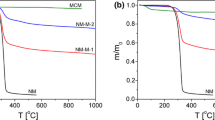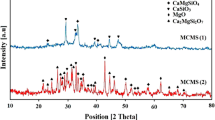Abstract
In this study, mesoporous SnO2 (MSn) with a three-dimensional mesoporous structure was prepared using MCM-48 as the template in order to increase the oral bioavailability and dissolution rate of insoluble drugs. The model drug, nitrendipine (NDP), was loaded into the MSn by the adsorption method. The structural features of MSn were characterized by transmission electron microscopy (TEM), scanning electron microscopy (SEM), and N2 adsorption (desorption) analysis. NDP was existed in the pore channels of MSn in an amorphous state, which was characterized by powder X-ray diffraction (PXRD), differential scanning calorimetry (DSC), and Fourier transform infrared spectroscopy (FTIR). MSn showed a good biocompatibility in the cell toxicity assay for Caco-2 cells. In vitro dissolution results suggested that MSn could significantly enhance the dissolution rate of NDP compared with commercial NDP tablets. Pharmacokinetic studies indicated that NDP-MSn tablets effectively enhanced the oral bioavailability of NDP. In conclusion, MSn was found to be a potential carrier for improving the solubility of insoluble drugs.










Similar content being viewed by others
References
Alsante KM, Ando A, Brown R, Ensing J, Hatajik TD, Kong W, et al. The role of degradant profiling in active pharmaceutical ingredients and drug products. Adv Drug Deliver Rev. 2007;59(1):29–37.
Blagden N, de Matas M, Gavan PT, York P. Crystal engineering of active pharmaceutical ingredients to improve solubility and dissolution rates. Adv Drug Deliver Rev. 2007;59(7):617–30.
Prachi BS, Varsha BP. Understanding peroral absorption: regulatory aspects and contemporary approaches to tackling solubility and permeability hurdles. Acta Pharm Sin B. 2017;7(3):260–80.
Tiwari G, Tiwari R, Rai AK. Cyclodextrins in delivery systems: applications. J Pharm Bio Sci. 2010;2(2):72–9.
Yohei K, Koichi W, Manabu N, Shizuo Y, Satomi O. Formulation design for poorly water-soluble drugs based on biopharmaceutics classification system: basic approaches and practical applications. Int J Pharm. 2011;420(1):1–10.
Jiahui H, Johnston KP, Williams RO III. Spray freezing into liquid (SFL) particle engineering technology to enhance dissolution of poorly water soluble drugs: organic solvent versus organic/aqueous co-solvent systems. Eur J Pharm Sci. 2003;20(3):295–303.
Maheshwari RK. Mixed-solvency approach-boon for solubilization of poorly water-soluble drugs. ASIA. J Pharm Sci. 2014;4(1):60–3.
Greenwald RB, Gilbert CW, Pendri A, Conover CD, Xia J, Martinez A. Drug delivery systems: water soluble Taxol 2 ‘-poly (ethylene glycol) Ester prodrugs design and in vivo effectiveness. J Med Chem. 1996;39(2):424–31.
Anil KP, Jolanta FKL, James RJB. Targeted drug delivery with dendrimers: comparison of the release kinetics of covalently conjugated drug and non-covalent drug inclusion complex. Adv Drug Deliver Rev. 2005;57(15):2203–14.
Lukyanov AN, Torchilin VP. Micelles from lipid derivatives of water-soluble polymers as delivery systems for poorly soluble drugs. Adv Drug Deliver Rev. 2004;56(9):1273–89.
Lei G, Dianrui Z, Minghui C. Drug nanocrystals for the formulation of poorly soluble drugs and its application as a potential drug delivery system. J Nanopart Res. 2008;10(5):845–62.
Kawakami K, Yoshikawa T, Moroto Y, Kanaoka E, Takahashi K, Nishihara Y, et al. Microemulsion formulation for enhanced absorption of poorly soluble drugs: I. Prescription design. J Control Release. 2002;81(1–2):65–74.
Serajuddin A. Solid dispersion of poorly water-soluble drugs: early promises, subsequent problems, and recent breakthroughs. J Pharm Sci-US. 1999;88(10):1058–66.
Nikhil B. Modified mesoporous silica nanoparticles for enhancing oral bioavailability and antihypertensive activity of poorly water soluble valsartan. Eur J Pharm Sci. 2017;99:152–60.
Aziz M, Helene K, Aurélie S, Jessica MR, Valeria A, Mehrdad H. Mesoporous silica materials: from physico-chemical properties to enhanced dissolution of poorly water-soluble drugs. J Control Release. 2017;268(28):329–47.
Yanzhuo Z, Zhuangzhi Z, Tongying J, Jinghai Z, Wang Z, Siling W. Spherical mesoporous silica nanoparticles for loading and release of the poorly water-soluble drug telmisartan. J Control Release. 2010;145(3):257–63.
Aitana T, Alejandra M, Roberto RC, Araceli MI, Luis MB, Dolores VO, et al. Mesoporous silicon oxycarbide materials for controlled drug delivery systems. Chem EngJ. 2015;280:165–74.
Xiufang W, Ping L, Yong T, Linquan Z. Novel synthesis of Fe-containing mesoporous carbons and their release of ibuprofen. Micropor Mesopor Mat. 2011;145(1–3):98–103.
Patricia H, Christian S, María VR, Muriel S, Francis T, Gérard F. Metal-organic frameworks as efficient materials for drug delivery. Angew Chem. 2006;118(36):6120–4.
Ranjit T, Amit D, William J, Maya PL, Lilly R, Naír RH. Pharmaceutical cocrystals and poorly soluble drugs. Int J Pharm. 2013;453:101–25.
Mehdi Y, Sana F, Soroush B, Iman G, Hassan F, Hamidreza M. Facile synthesis of chitosan/ZnO bio-nanocomposite hydrogel beads as drug delivery systems. Int J Biol Macromol. 2016;82:273–8.
Zhila ZA, Hassan F, Behrouz FN, Saeedeh A, Mehdi Y, Mohammad KG. PH-sensitive bionanocomposite hydrogel beads based on carboxymethyl cellulose/ZnO nanoparticle as drug carrier. Int J Biol Macromol. 2016;93:1317–27.
Javed R, Ahmed M, Haq I, Nisa S, Zia M. PVP and PEG doped CuO nanoparticles are more biologically active: antibacterial, antioxidant, antidiabetic and cytotoxic perspective. Mat Sci Eng C-Mater. 2017;79(1):108–15.
Farzaneh S, Ida IM. Acrylamide-based hydrogel drug delivery systems: release of acyclovir from MgO nanocomposite hydrogel. J Taiwan Inst Chem E 2017;72:182–193.
Ana MD, Angel LD. Antibacterial SnO2 nanorods as efficient fillers of poly (propylene fumarate-co-ethylene glycol) biomaterials. Mat Sci Eng C-Mater. 2017;78:806–16.
Na C, Miao L, Yanbao Z, Li Q, Xueyan Z, Yu Z, et al. Fabrication of SnO2/porous silica/polyethyleneimine nanoparticles for pH-responsive drug delivery. Mat Sci Eng C-Mater. 2016;59:319–23.
Jibin G, Nana Z, Yinglei Z, Chunxia C, Hongming C, Tianhong Z. Pharmacokinetic performance of the nitrendipine intravenous submicron emulsion in rats. Asian J Pharm Sci. 2014;9:330–5.
Kaneda M, Tsubakiyama T, Carlsson A, Sakamoto Y, Ohsuna T, Terasaki O. Structural study of mesoporous MCM-48 and carbon networks synthesized in the spaces of MCM-48 by electron crystallography. J Phys Chem B. 2002;106(6):1256–66.
Jie X, Zhaohua L, Heyong H, Wuzong Z, Larry K. A reliable synthesis of cubic mesoporous MCM-48 molecular sieve. Chem Mater. 1998;10:3690–8.
Swasmi P, Hongwei Z, Xiaodan H, Hao S, Yannan Y, Jun Z, et al. Mesoporous magnesium oxide hollow spheres as superior arsenite adsorbent: synthesis and adsorption behavior. ACS Appl Mater Inter. 2016;8:25306–12.
Pierrick G, Sophie D, Habiba N, Joël P, Jean FB, Emmanuel F, et al. Synthesis of CuO/SBA-15 adsorbents for sox removal applications, using different impregnation methods. C R Chim. 2015;18:1013–29.
Peng Q, Dengning X, Hongze P, Hongyu P, Kai S, Yinnong J, et al. Nitrendipine nanocrystals: its preparation, characterization, and in vitro-in vivo evaluation. AAPS PharmSciTech. 2011;12(4):1136–43.
Priya VS, Sadhana JR. A comparative in vitro release study of raloxifene encapsulated ordered MCM-41 and MCM-48 nanoparticles: a dissolution kinetics study in simulated and biorelevant media. J Drug Deliv Sci Tec. 2017;41:31–44.
Ying Z, Chao W, Zongzhe Z, Yanna H, Jie X, Tong Y, et al. Preparation of starch macrocellular foam for increasing the dissolution rate of poorly water-soluble drugs. Pharm Dev Technol. 2016;21(6):749–54.
Peng Q, Kai S, Hongze P, Hongyu P, Na L, Dengning X, et al. A novel surface modified nitrendipine nanocrystals with enhancement of bioavailability and stability. Int J Pharm. 2012;430:366–71.
Ghasemi S, Farsangi ZJ, Beitollahi A, Mirkazemi M, Rezayat SM, Sarkar S. Synthesis of hollow mesoporous silica (HMS) nanoparticles as a candidate for sulfasalazine drug loading. Ceram Int. 2017;43:11225–32. https://doi.org/10.1016/S0272-8842(17)30983-5.
Hongjian G, Yating Z, Jia L, Yu C, Ying W, Qinfu Z, et al. Hollow mesoporous silica as a high drug loading carrier for regulation insoluble drug release. Int J Pharm. 2016;510:184–94.
Basu SK, Adhiyaman R. Preparation and characterization of nitrendipine-loaded Eudragit RL 100 microspheres prepared by an emulsion-solvent evaporation method. Trop J Pharm Res. 2008;7(3):1033–41.
Yangong Z, Jing W, Pengjun Y. Formaldehyde sensing properties of electrospun NiO-doped SnO2 nanofibers. Sesors Actuat B-Chem. 2011;156(2):723–30.
Jing L, Na F, Chang L, Jian W, Sanming L, Zhonggui H. The tracking of interfacial interaction of amorphous solid dispersions formed by water-soluble polymer and nitrendipine. Appl Surf Sci. 2017;420:136–44.
Yanna H, Chao W, Zongzhe Z, Ying Z, Jie X, Yang Q, et al. Development of a novel starch with a three-dimensional ordered macroporous structure for improving the dissolution rate of felodipine. Mat Sci Eng C-Mater. 2016;58:1131–7.
Tianshi F, Huayu T, Caina X, Lin L, Zhigang X, Michael HL, et al. Synergistic co-delivery of doxorubicin andpaclitaxelby porous PLGA microspheres for pulmonary inhalation treatment. Eur J Pharm Biophar. 2014;88:1086–93.
Hai W, Ying Z, Yan W, Yulin H, Kaihui N, Guangjun N, et al. Enhanced anti-tumor efficacy by co-delivery of doxorubicin and paclitaxel with amphiphilic methoxy PEG-PLGA copolymer nanoparticles. Biomaterials. 2011;32:8281–90.
Kesisoglou F, Panmai S, Yunhui W. Nanosizing-oral formulation development and biopharmaceutical evaluation. Adv Drug Deliv Rev. 2007;59:631–44.
Dengning X, Peng Q, Hongze P, Hongyu P, Shaoping S, Yongmei Y, et al. Preparation of stable nitrendipine nanosuspensions using the precipitation-ultrasonication method for enhancement of dissolution and oral bioavailability. Eur J Pharm Sci. 2010;40:325–34.
Cogswell S, Berger S, Waterhouse D, Bally MB, Wasan EK. A parenteral econazole formulation using a novel micelle-to-liposome transfer method: in vitro characterization and tumor growth delay in a breast cancer xenograft model. Pharm Res. 2006;23:2575–85.
Shchekin AK, Rusanov AI. Generalization of the Gibbs-Kelvin-Köhler and Ostwald-Freundlich equations for a liquid film on a soluble nanoparticle. J Chem Phys. 2008;129:154116.
Acknowledgments
This study was supported by the National Natural Science Foundation of China (no. 81302707), the Natural Science Foundation of Liaoning Province (no. 20170540366), Liaoning province talent project support programs in colleges and universities (no. LJQ2015065), and the Principal Fund-Aohong-boze-clinical medicine construction Special Fund (no. XZJJ20140205).
Author information
Authors and Affiliations
Corresponding author
Additional information
Analysis of mesoporous SnO2 as a new medicinal excipient
Rights and permissions
About this article
Cite this article
Liu, X., Wu, C., Bai, A. et al. Preparation of a Mesoporous Structure of SnO2 for Increasing the Oral Bioavailability and Dissolution Rate of Nitrendipine. AAPS PharmSciTech 19, 3228–3236 (2018). https://doi.org/10.1208/s12249-018-1117-x
Received:
Accepted:
Published:
Issue Date:
DOI: https://doi.org/10.1208/s12249-018-1117-x




